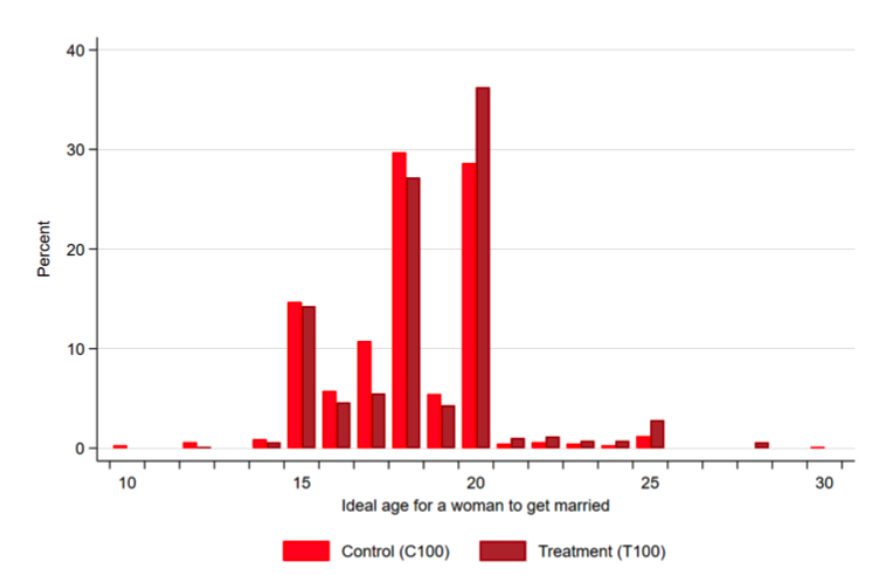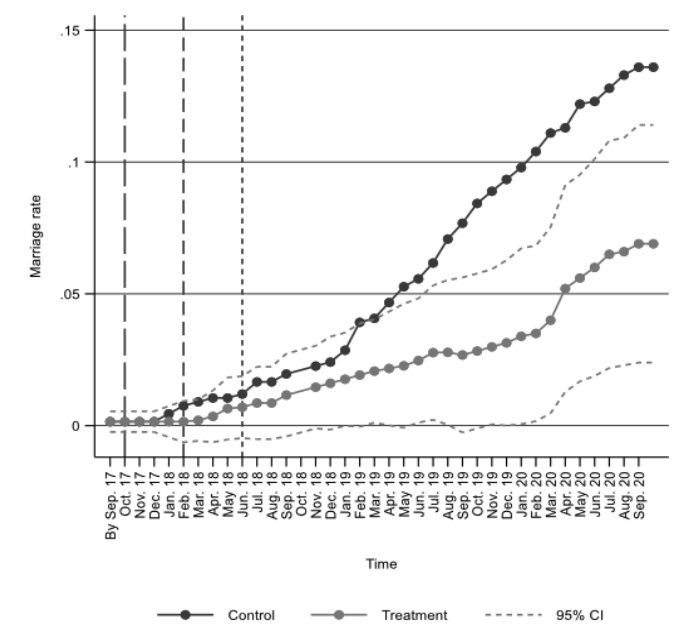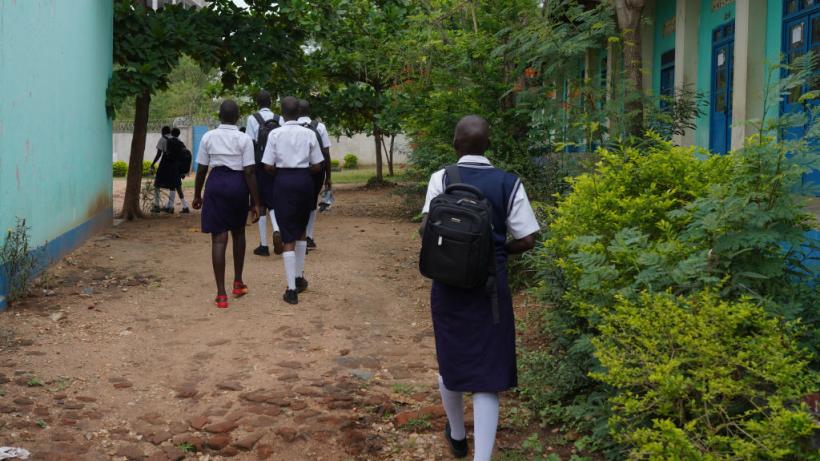Early marriage and pregnancy can be detrimental to women’s health, agency, and labour market outcomes. However, compelling evidence from sub-Saharan Africa (SSA) shows that each additional year of secondary education mitigates these risks in both the short- and long-term.
Over the last two decades, SSA has made enormous progress in increasing access to schooling in pursuit of universal primary education. However, secondary education remains a challenge with enrolment rates at only 43.6% in the region (World Bank, 2019). Due to a high incidence of school dropout, girls systematically lag behind in terms of school completion, literacy and educational attainment. For instance, less than 15% of girls complete lower secondary education in the Central African Republic, Chad, and South Sudan, while less than 30% do so in Angola, Equatorial Guinea, Guinea, Guinea-Bissau, Malawi, Mali, Niger, and Uganda. The explosion of teenage pregnancies caused by school closures during the COVID-19 pandemic is likely to compound this gender gap for a whole generation, and illustrates the critical role of secondary education in reducing gender inequality (Mo Ibrahim Foundation, 2021).
Leveraging secondary education to empower women in SSA
Ensuring that all girls can access secondary education is not only a right but also a crucial step in achieving gender equality in all aspects of women’s lives. The gender gap in secondary education leads to gender gaps in higher education and in human capital accumulation as women’s literacy continues to lag behind men’s literacy (UNESCO, 2015). Women are hence less likely to participate in the labour market or find quality and skilled jobs, and when they do, their earnings are typically lower than their male counterparts. Allowing teenage girls to remain in school is therefore instrumental in advancing women’s economic independence, agency, and overall empowerment (Friedman et al., 2016).
Secondary education plays a significant role in reducing early marriage and pregnancy (Wodon et al., 2018), both of which are known to be harmful for girls’ and children’s health. Adolescent girls are at greater risk of experiencing pregnancy and delivery complications such as hypertension, obstructed labour, and fistulas, all of which increase maternal and child morbidity (Raj, 2010). In addition, women who marry very young have less decision-making power in their households and are more likely to experience domestic violence (Jensen and Thornton, 2003).
Girls access to secondary education face a range of challenges in SSA
While tuition fees for secondary school have been eliminated in most SSA countries, households still face substantial direct and opportunity costs when sending their children to school. Rural households often do not have a secondary school in their village, and girls have to use costly transport or walk long distances each day, raising safety concerns. To overcome this obstacle, families often resort to the widespread host-family system in which a girl spends the school week with a host family living closer to the secondary school and the girl’s family pays the host family in return. Additionally, households incur other additional costs such as for uniforms and school supplies. Enrolling in secondary school may also entail opportunity costs as girls habitually contribute to household chores and economic activities. While the costs of education are immediately observable, the benefits of secondary schooling are perceived as uncertain and in the distant future. The economic returns to secondary education are often underestimated in a context with few opportunities in the labour market, especially due to a lack of information (Nguyen, 2008). In addition, the influence of norms assigning women to traditional gender roles of wife, mother, and/or housekeeper may not generate enough incentive to enrol in secondary school, especially if it is costly.
Early marriage and pregnancy are some of the main causes of secondary school dropout since girls’ responsibilities as wives and mothers are incompatible with school attendance (Perlman et al.,2018; Mensch et al., 2005; Omoeva et al., 2014). In addition, teenage mothers face stigma and discrimination at school from teachers and peers, which makes the possibility of them returning to school even more complicated (Bhana et al., 2010).
The promising results of secondary school scholarships programmes in SSA
To date, only two experimental studies in SSA have estimated the causal impact of programmes alleviating the costs of secondary education (through scholarships) on girls’ life trajectories. Duflo et al. (2021) conducted a randomised controlled trial (RCT) in Ghana in which four-year, full scholarships were awarded to randomly selected adolescents who had gained admission to a public high school. The subsidy paid to the school was meant to cover senior high school tuitions fees which represents 20% of GDP per capita. Giacobino et al. (2022) also conducted an experiment in rural Niger with a scholarship programme targeting younger girls of about age 13. Eligible girls had to complete primary school with the requisite grades to be admitted to lower secondary school. Since secondary education is free in Niger, the subsidy paid to the family was meant to cover other out-of-pocket costs (e.g., host family fees, transport, school supplies). Those costs remained the families’ responsibility in Ghana, implying that the families targeted in Niger were poorer.
In Niger, the programme had a very large impact on school enrolment. The dropout rate decreased by half among the eligible girls three year after the beginning of the intervention. In Ghana, the scholarships multiplied the enrolment rate by four and increased senior high school completion by 69% among women. The programme also significantly increased girls’ access to tertiary education, bridging the gender gap in attendance. These findings confirm that both direct and opportunity costs constitute important barriers to girls’ secondary schooling. The programmes also improved girls’ cognitive skills – those who received the scholarship scored 0.19 (Ghana) and 0.15 (Niger) standard deviations higher in reading and mathematics tests five and three years later, respectively.
In addition, receiving the scholarship significantly increased girls’ educational and professional aspirations in both countries. For instance, in Niger, beneficiaries were 53% more likely to have an interest in pursuing higher education and show more interest in having a modern occupation. The self-reported ideal age of marriage for girls increased by about nine months (see Figure 1).
Figure 1: Impact of scholarships on self-reported preferred marriage age for girls in Niger

Note: This figure depicts the impact of the intervention on girls’ ideal age of marriage in Niger (Giacobino et al., 2022). In the pure control group, 11% of girls report that the ideal age of marriage is 17, against 5% in the full treatment group.
Staying in secondary school in Niger halved the probability of girls being married three years later. As shown in Figure 2, the spike in marriages that would otherwise occur at age 14.5 was delayed by more than a year as a result of the scholarships. Reducing the cost of accessing secondary school proved to be a powerful tool in curtailing early marriage: each additional year spent in secondary school decreased the probability of getting married by 19 percentage points. In Ghana, 22-years old women who benefited from the scholarship were 14% less likely to be pregnant. This effect persisted once most of the beneficiaries left school.
Figure 2: Impact of scholarships on actual marriage age for girls in Niger

Notes: This figure depicts the impact of the intervention on girls’ marriage rate, which is measured every month from the intervention start date (using information about the date of their first marriage) (Giacobino et al., 2022). The dashed lines on each side of the marriage rate estimate in the treatment group represent the 95 percent confidence interval. The first vertical dotted line indicates the beginning of the 2017-18 school year. The second vertical dotted line indicates the moment when respondents were informed of whether or not they would receive the intervention. The third vertical dotted line indicates the date of the first scholarship disbursement.
In Ghana, increased access to secondary school improved women’s labour market outcomes along various dimensions. Women who received the secondary education scholarship were 3.4 percentage points more likely to be employed in the public sector nine years later. This represents an improvement in job quality when considering the various advantages of public sector employment, notably in terms of wages, benefits, and job security. Similarly, among self-employed women, scholarship beneficiaries are more likely to own a firm in the formal sector and therefore have better labour market outcomes.
These recent studies bring strong empirical evidence that promoting girls’ secondary education is a strong lever to reduce early marriage and pregnancy, and further improve girls’ life-long trajectories. The large impacts of scholarship programs suggest that even minor residual costs to education can impede girls schooling among the poorest families. In terms of policy recommendations, it implies that efforts to eliminate any cost to girls’ access to secondary education may pay large and multiple dividends for gender equality.
This article is part of our gender equality series.


